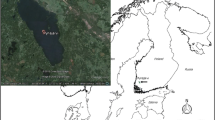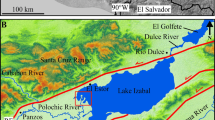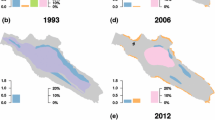Abstract
The floating fern,Salvinia molesta Mitch., underwent explosive growth following the creation of Lake Kariba in 1958. By 1962 this aquatic weed covered 22% of the Lake's surface but later declined to an apparently stable level of 10–15%. Coverage declined again in 1973 to 5% and by 1980 only about 1% of the lake was covered bySalvinia. This paper discusses the ecological context in which this decline took place and the role of the introduced neotropical grasshopper,Paulinia acuminata De Geer. This insect appears to have made a major contribution towards the decline ofSalvinia, but it is suggested that its effect was greatly enhanced by nutrient stress onSalvinia because of competition for nutrients between the floating weed and other ecosystem components. Nutrient supply to Lake Kariba is limited and the increasing requirements of submerged macrophyte, mussel and fish populations, which are all expanding probably reduced nutrient availability toSalvinia. Mussels and fish, with standing crops of 167 000t and 30 000t, respectively, are seen as particularly important nutrient reservoirs. It is concluded that the decline ofSalvinia in Kariba was part of the lake's maturation process and could possibly have occurred without the introduction ofPaulinia, but at a much slower rate.
Similar content being viewed by others
References
Balinsky, B. I. & James, G. V., 1960. Explosive reproduction of organisms in the Kariba lake. S. Afr. J. Sci. 56: 101–104.
Balon, E. K., 1974. Fish production of a tropical ecosystem. In: Lake Kariba: A man-made ecosystem in tropical Africa., E. K. Balon & A. G. Coche Eds., The Hague: Dr. W. Junk., pp. 253–573.
Begg, G. W., 1970. Limnological observations on Lake Kariba during 1967, with emphasis on some special features. Limnol. Oceanogr. 15: 776–788.
Begg, G. W., 1973. The biological consequences of discharge above and below Kariba dam. 11th Congr. Grands Barr. Madrid, 1973, pp. 421–430.
Begg, G. W., 1974. The influence of thermal and oxygen stratification on the vertical distribution of zooplankton at the mouth of the Sanyati Gorge, Lake Kariba. Kariba Studies, Paper 4: 60–67.
Bell-Cross, G. & Bell-Cross, B., 1971. Introduction of Limnothrissa miodon and Limnocaradina tanganicae from Lake Tanganyika into Lake Kariba. Fish. Res. Bull. Zambia 5: 207–214.
Boughey, A. S., 1963. The explosive development of a floating weed vegetation on Lake Kariba. Adansonia 3: 49–61.
Bowmaker, A. P., 1968. Preliminary observations on some aspects of the biology of the Sinamwenda estuary, Lake Kariba. Proc. Trans. Rhod. Sci. Assoc. 53: 3–8.
Bowmaker, A. P., 1973. Hydrophyte dynamics in M wend a Bay, Lake Kariba. Kariba Studies, Paper 3: 42–59.
Bowmaker, A. P., 1976. The physico-chemical limnology of the Mwenda river mouth, Lake Kariba. Arch. Hydrobiol. 77: 66–108.
Chisholm, I. F., 1979. A laboratory investigation ofPaulinia acuminata (De Geer) (Orthoptera: Acrididae) as a biological control agent forSalvinia molesta. Bull. Ent. Res. 69: 111–114.
Cochrane, K. L., 1978. Seasonal fluctuations in the catches of Limnothrissa miodon (Boulenger) in Lake Kariba. Lake Kariba Fish. Res. Inst. Proj. Rept. 29: 1–163 (cyclostyled).
Coulter, G. W., 1977. Approaches to estimating fish biomass and potential yield in Lake Tanganyika. J. Fish. Biol. 11: 393–408.
Donnelly, B. G., 1969. A preliminary survey of Tilapia murseries on Lake Kariba. Hydrobiologia 34: 195–206.
French, R. A., 1980. An assessment of mussel mortality caused by a drop in the water level of Lake Kariba. Lake Kariba Fish. Res. Inst. Proj. Rept. 34: 1–12 (cyclostyled).
Gaudet, J. J., 1979. Aquatic weeds in African man-made lakes. PANS 25: 279–286.
Hall, A., Davies, B. R. & Valente, I., 1976. Cabora Bassa: some preliminary physico-chemical and zooplankton preimpoundment survey results. Hydrobiologia 50: 17–25.
Hall, D. J., Cooper, W. E. & Werner, E. E., 1970. An experimental approach to the production dynamics and structure of freshwater animal communities. Limnol. Oceanogr. 15: 839–928.
Harding, D., 1966. Lake Kariba: the hydrology and development of fisheries. In: Man-made lakes. R. H. LoweMcConnell Ed., London: Academic Press., pp. 7–20.
Jacot Guillarmod, A., 1979. Water weeds in southern Africa. Aquatic Botany 6: 377–391.
Junor, F. J. R. & Begg, G. W., 1971. A note on the successful introduction of Limnothrissa miodon (Boulenger) ‘the Lake Tanganyika sardine’ to Lake Kariba. Newslett. Limnol. Soc. Sthn. Afr. 16: 8–14.
Kenmuir, D. H. S., 1980. The mussel resources of Lake Kariba. Trans. Zimbabwe Scient. Assoc. 60: 7–10.
Magadza, C. H. D., 1970. A preliminary survey of the vegetation of the shore of Lake Kariba. Kirkia 7: 253–267.
Marshall, B. E., 1979a. The current status of Salvinia molesta in Lake Kariba. Lake Kariba Fish. Res. Inst. Proj. Rept. 33: 1–15 (cyclostyled).
Marshall, B. E., 1979b. Fish populations and fisheries potential of Lake Kariba. S. Afr. J. Sci. 75: 485–488.
McLachlan, A. J., 1969a. Some effects of water level fluctuation on the benthic fauna of two Central African lakes. Newslett. Limnol. Soc. Sthn. Afr. 13: 58–63.
McLachlan, A. J., 1969b. The effect of aquatic macrophytes on the variety and abundance of benthic fauna in a newlycreated lake in the tropics (Lake Kariba). Arch. Hydrobiol. 66: 212–231.
McLachlan, A. J., 1970a. Some effects of the annual fluctuations of water level on the larval chironomid communities of Lake Kariba. J. Anim. Ecol. 39: 79–90.
McLachlan, A. J., 1979b. Submerged trees as a substrate for benthic fauna in the recently-created Lake Kariba (Central Africa). J. Appl. Ecol. 7: 253–266.
McLachlan, A. J., 1974. Development of some lake ecosystems in tropical Africa, with special reference to the invertebrates. Biol. Rev. 49: 365–397.
McLachlan, S. M., 1970. The influence of lake level fluctuations and the thermocline on water chemistry in two gradually shelving areas of Lake Kariba, Central Africa. Arch. Hydrobiol. 66: 499–510.
McLachlan, S. M., 1971. The rate of nutrient release from grass and dung following immersion in lake water. Hydrobiologia 37: 521–530.
Mitchell, D. S., 1969. The ecology of vascular hydrophytes on Lake Kariba. Hydrobiologia 34: 448–464.
Mitchell, D. S., 1970. The autecology of Salvinia auriculata Aubl. Ph. D. thesis, Univ. of London.
Mitchell, D. S., 1973a. Supply of plant nutrient chemicals of Lake Kariba. In: Man-made lakes: their problems and environmental effects, W. C. Ackermann, G. F. White & E. B. Worthington Eds., Washington, D.C.: Am. Geophys. Union, pp. 165–169.
Mitchell, D. S., 1973b. Aquatic weeds in man-made lakes. In: Man-made lakes: their problems and environmental effects, W. C. Ackermann, G. F. White & E. B. Worthington Eds., Washington, D.C.: Am. Geophys. Union, pp. 606–611.
Mitchell, D. S. & Rose, D. J. W., 1979. Factors effecting fluctuations in extent of Salvinia molesta on Lake Kariba. Pans 25: 171–177.
Michell, S.A., 1976. The marginal fish fauna of Lake Kariba. Kariba Studies paper 8: 109–162.
Rhodesia, 1973. Hydrological Yearbook, 1972–73. Salisbury: Ministry of Water Development.
Rhodesia, 1975. Hydrological Summaries, 1970. Salisbury: Ministry of Water Development.
Schelpe, E. A., 1961. The ecology of Salvinia auriculata and associated vegetation in Lake Kariba. J.S. Afr. Bot. 27: 181–187.
Sculthorpe, C. D., 1967. The biology of aquatic vascular plants. London: Edward Arnold.
Taylor, R. D., 1979. Biological conservation in Matusadonna National Park, Kariba. Trans. Rhod. Sci. Assoc. 59: 30–40.
Thomas, P. A., 1974. Investigations into the biology of Paulinia acuminata (De Geer) (Orthoptera: Acrididae) with particular reference to the biological control of Salvinia auriculata. M. Phil. thesis, Univ. of London.
Thornton, J. A., 1980. A review of Limnology in Zimbabwe: 1959–1979. National Water Quality Survey Report Series. 1: 1–86. Salisbury: Ministry of Water Development.
Trethowan, S. C., 1973. Handbook and guide to Rhodesian Waters. Salisbury: Sarum Imprint.
Van der Lingen, M. I., 1973. Lake Kariba: early history and south shore. In: Man-made lakes: their problems and environmental effects, W. C. Ackermann, G. F. White & E.B. Worthington Eds., Washington, D.C.: Am. Geophys. Union, pp. 133–142.
Author information
Authors and Affiliations
Rights and permissions
About this article
Cite this article
Marshall, B.E., Junor, F.J.R. The decline of Salvinia molesta on Lake Kariba. Hydrobiologia 83, 477–484 (1981). https://doi.org/10.1007/BF02187043
Received:
Issue Date:
DOI: https://doi.org/10.1007/BF02187043




